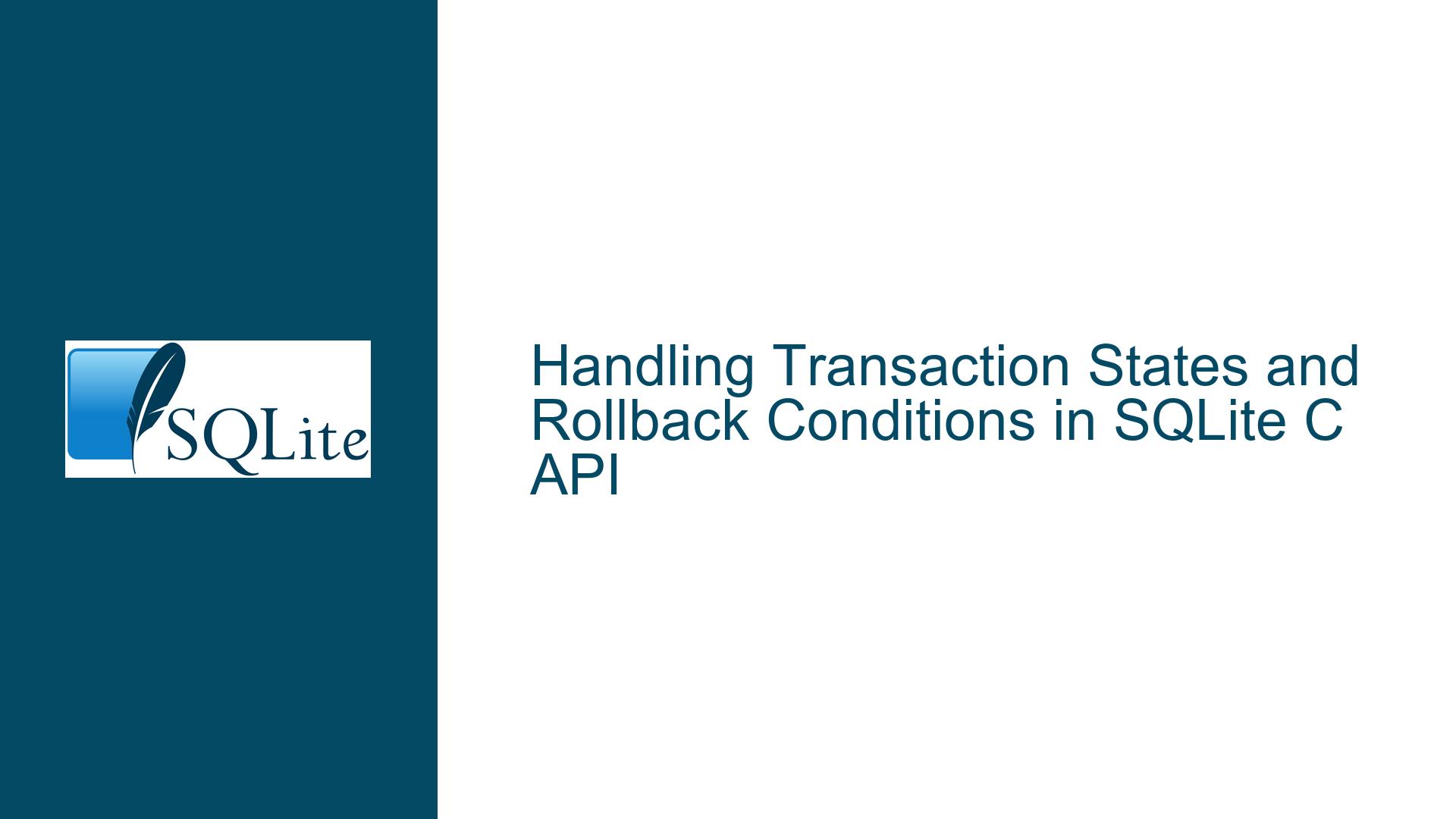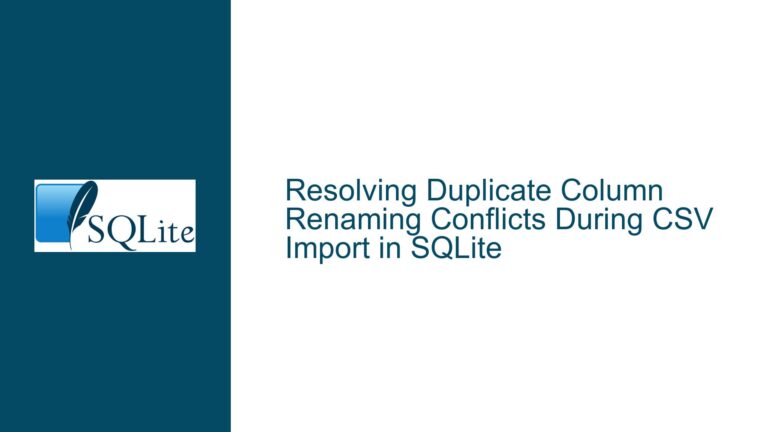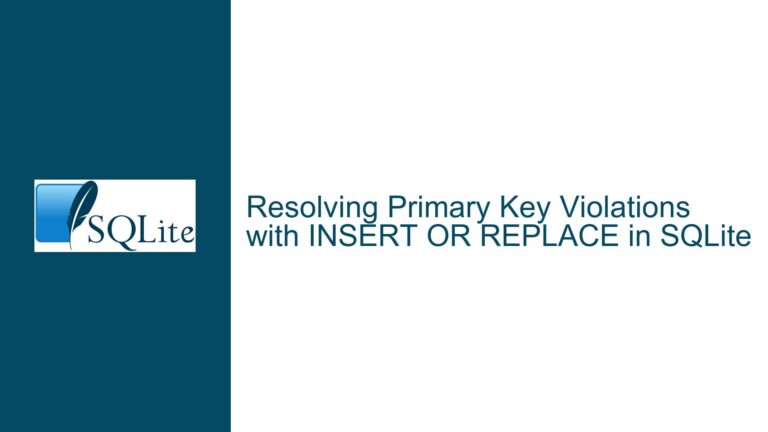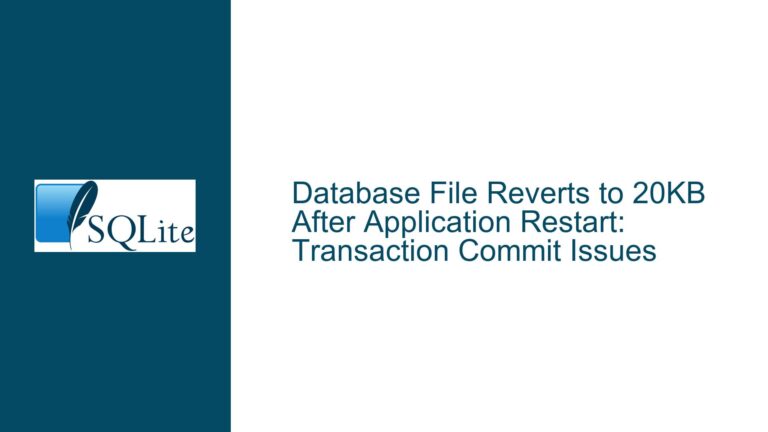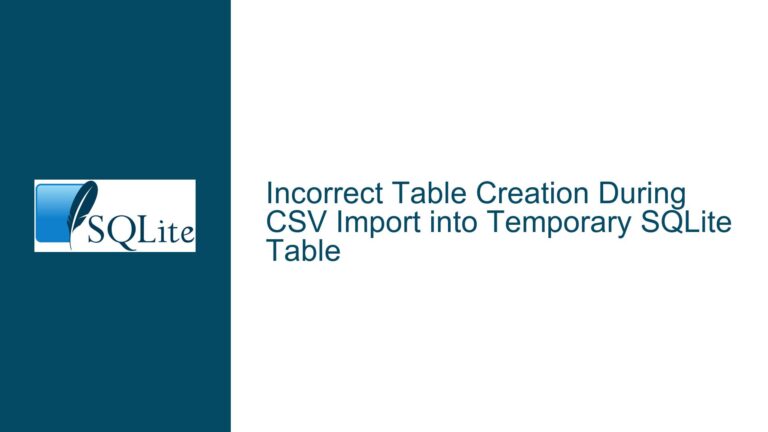Handling Transaction States and Rollback Conditions in SQLite C API
Understanding Transaction State Management in SQLite
The core challenge in this scenario revolves around programmatically determining whether a transaction is active within an SQLite database connection when specific API functions return non-OK status codes. This is critical for deciding whether to issue ROLLBACK commands while processing user-provided SQL that may or may not contain explicit transaction boundaries. The fundamental complexity stems from SQLite’s dual transaction handling modes: autocommit mode (default) and explicit transaction mode, coupled with the need to avoid invalid transaction operations that could corrupt application state.
When working with SQLite’s C API, developers interact with transactions through three primary stages:
- Transaction initiation via BEGIN/START TRANSACTION
- Transaction progression through CRUD operations
- Transaction termination via COMMIT/ROLLBACK
The ambiguity arises when handling errors or busy states during statement preparation (sqlite3_prepare_v2) and execution (sqlite3_step). A failed prepare operation might leave the database in an indeterminate state regarding transactions, particularly when processing arbitrary user SQL that could contain nested transactions. The critical questions involve:
- Whether to rollback on prepare failure
- How to verify transaction existence before rollback/commit
- Proper handling of BUSY states during execution
SQLite’s transactional model operates under these key principles:
- Autocommit mode automatically wraps individual statements in transactions
- Explicit transactions disable autocommit until committed/rolled back
- Nested transactions are simulated using savepoints
- Write transactions require exclusive access to the database
The confusion manifests when application code must handle transactions initiated outside its direct control (e.g., user-provided BEGIN commands) while avoiding invalid state transitions. A failed SQL operation might leave an implicit transaction open, requiring cleanup, but blindly issuing ROLLBACK could interfere with higher-level transaction management.
Transaction State Tracking Challenges and API Misconceptions
Four primary factors contribute to the difficulty in handling transaction states programmatically:
1. Autocommit Ambiguity
The default autocommit mode creates implicit transactions for every statement not wrapped in explicit BEGIN..COMMIT blocks. However, these implicit transactions commit automatically unless interrupted by errors. Developers often mistake SQLITE_BUSY or SQLITE_LOCKED errors as requiring manual rollback when in reality, the implicit transaction has already been rolled back by SQLite.
2. Schema Name Requirements in Transaction State APIs
The sqlite3_txn_state() function requires both a database connection handle and a schema name (e.g., "main", "temp", attached databases). Many developers overlook that SQLite supports multiple database schemas per connection through ATTACH DATABASE, making transaction state checks schema-specific. Retrieving the active schema requires additional API calls like sqlite3_db_name() or tracking schema usage in application code.
3. Read vs Write Transaction Confusion
SQLITE_TXN_READ state indicates an active read transaction (START TRANSACTION READ ONLY), which doesn’t require explicit COMMIT/ROLLBACK in autocommit mode. Many developers incorrectly attempt to roll back read transactions, leading to SQLITE_ERROR (no active transaction). Write transactions (SQLITE_TXN_WRITE) require explicit termination.
4. API Function Misapplication
Confusion between sqlite3_get_autocommit() and sqlite3_txn_state() often occurs:
- sqlite3_get_autocommit() returns 0 when any transaction is active (explicit or implicit)
- sqlite3_txn_state() provides granular read/write state per schema
Developers might check autocommit status when they need transaction depth information, or vice versa.
5. Error State Propagation
When sqlite3_prepare_v2() fails, the database connection enters an error state where subsequent API calls return SQLITE_MISUSE until sqlite3_reset() or sqlite3_finalize() is called. Attempting to check transaction state during this error state produces unreliable results.
6. Busy Handler Complications
SQLITE_BUSY from sqlite3_step() indicates contention for database locks. Some developers assume the transaction remains active during retries, but depending on the isolation level and lock acquisition timing, the transaction may have been rolled back automatically, leading to false assumptions about transaction state.
7. Savepoint vs Transaction Confusion
SAVEPOINTs implement nested transactions but use different syntax (RELEASE/ROLLBACK TO). Applications checking transaction state might misinterpret savepoint levels as top-level transactions.
Programmatically Determining Transaction States and Safe Rollback Procedures
Schema Identification for Transaction State Checks
To use sqlite3_txn_state() effectively, first identify the target schema name:
// For main database
const char *schema = "main";
// For attached databases (iterate through all attached)
int db_count = sqlite3_db_count(db_handle);
for(int i=0; i<db_count; i++){
const char *schema_name = sqlite3_db_name(db_handle, i);
int txn_state = sqlite3_txn_state(db_handle, schema_name);
}
Transaction State Decision Matrix
| API Return Code | sqlite3_get_autocommit() | sqlite3_txn_state() | Required Action |
|---|---|---|---|
| SQLITE_OK | 1 | SQLITE_TXN_NONE | No transaction |
| SQLITE_BUSY | 0 | SQLITE_TXN_WRITE | Retry step |
| SQLITE_ERROR | 0 | SQLITE_TXN_READ | Finalize stmt |
| SQLITE_DONE | 0 | SQLITE_TXN_WRITE | Consider commit |
Step-by-Step Transaction Handling
1. After sqlite3_prepare_v2() Failure
int rc = sqlite3_prepare_v2(db, sql, -1, &stmt, 0);
if(rc != SQLITE_OK){
if(sqlite3_get_autocommit(db) == 0){
// Transaction was active before prepare
sqlite3_exec(db, "ROLLBACK", 0, 0, 0);
}
// Always check error codes after rollback
handle_error(db);
}
2. Handling sqlite3_step() Results
For SQLITE_DONE:
if(sqlite3_step(stmt) == SQLITE_DONE){
if(sqlite3_get_autocommit(db) == 0){
// Explicit transaction in progress
if(user_initiated_transaction){
defer_commit_to_user_code();
} else {
sqlite3_exec(db, "COMMIT", 0, 0, 0);
}
}
// Autocommit transactions automatically finalized
}
For SQLITE_BUSY:
int attempts = 0;
while((rc = sqlite3_step(stmt)) == SQLITE_BUSY && attempts++ < MAX_RETRIES){
usleep(BUSY_TIMEOUT);
}
if(rc == SQLITE_BUSY){
if(sqlite3_txn_state(db, "main") == SQLITE_TXN_WRITE){
// Only rollback write transactions
sqlite3_exec(db, "ROLLBACK", 0, 0, 0);
}
handle_busy_error();
}
3. Safe Rollback Pattern
void safe_rollback(sqlite3 *db){
if(sqlite3_get_autocommit(db) == 0){
int txn_state = sqlite3_txn_state(db, "main");
if(txn_state == SQLITE_TXN_WRITE){
sqlite3_exec(db, "ROLLBACK", 0, 0, 0);
}
}
}
Transaction State Flow Control
- Before Any Operation
Check autocommit status:
int in_transaction = !sqlite3_get_autocommit(db);
- After Failed Prepare
- Finalize statement
- Check if connection still in transaction
- Rollback only if write transaction active
- During Busy Retries
- Maintain retry counter
- Check txn_state after each failure
- Rollback only if lock acquisition failed after multiple attempts
- Finalization Phase
- For explicit transactions:
if(user_owns_transaction && !sqlite3_get_autocommit(db)){
prompt_for_commit_or_rollback();
}
Advanced Techniques
Transaction Depth Tracking
Maintain application-side counter:
void exec_callback(void *depth, int cols, char **vals, char **names){
if(strcmp(vals[0], "BEGIN") == 0) (*(int*)depth)++;
if(strcmp(vals[0], "COMMIT") == 0) (*(int*)depth)--;
if(strcmp(vals[0], "ROLLBACK") == 0) (*(int*)depth)--;
}
int get_transaction_depth(sqlite3 *db){
static int depth = 0;
sqlite3_exec(db, "SELECT sql FROM sqlite_schema WHERE type='transaction'",
exec_callback, &depth, 0);
return depth;
}
Schema-Aware Rollback
void schema_safe_rollback(sqlite3 *db){
int db_count = sqlite3_db_count(db);
for(int i=0; i<db_count; i++){
const char *schema = sqlite3_db_name(db, i);
if(sqlite3_txn_state(db, schema) == SQLITE_TXN_WRITE){
char *sql = sqlite3_mprintf("ROLLBACK %s", schema);
sqlite3_exec(db, sql, 0, 0, 0);
sqlite3_free(sql);
}
}
}
Critical Best Practices
- Never Rollback Unknown Transactions
If your code didn’t initiate the transaction (via BEGIN), don’t issue ROLLBACK. Use:
if(!we_initiated_transaction && sqlite3_get_autocommit(db) == 0){
// Let higher-level code handle it
return SQLITE_BUSY;
}
- Use Savepoints for Nested Operations
Instead of relying on transaction state checks:
sqlite3_exec(db, "SAVEPOINT nested_op", 0, 0, 0);
// ... operations ...
if(error){
sqlite3_exec(db, "ROLLBACK TO nested_op", 0, 0, 0);
} else {
sqlite3_exec(db, "RELEASE nested_op", 0, 0, 0);
}
- Combine Autocommit and Txn State Checks
For reliable results:
int needs_rollback = 0;
if(sqlite3_get_autocommit(db) == 0){
switch(sqlite3_txn_state(db, "main")){
case SQLITE_TXN_WRITE: needs_rollback = 1; break;
case SQLITE_TXN_READ: /* Read transactions self-clean */ break;
}
}
- Handle Implicit Transactions Carefully
After DML statements in autocommit mode:
if(rc == SQLITE_DONE && sqlite3_get_autocommit(db)){
// No commit needed - autocommit handled it
}
Debugging Transaction State Issues
- Enable Tracing
sqlite3_trace_v2(db, SQLITE_TRACE_STMT | SQLITE_TRACE_PROFILE,
(int(*)(unsigned,void*,void*,void*))trace_cb, 0);
- Check Extended Error Codes
int errcode = sqlite3_extended_errcode(db);
if(errcode == SQLITE_READONLY || errcode == SQLITE_ABORT){
// Transaction may have been rolled back automatically
}
- Transaction State Assertions
Embed debug checks:
assert((sqlite3_get_autocommit(db) == 0) ==
(sqlite3_txn_state(db, "main") != SQLITE_TXN_NONE));
Performance Considerations
- Minimize Transaction State Checks
Cache transaction state locally rather than querying repeatedly:
int current_txn = !sqlite3_get_autocommit(db);
- Batch Operations in Explicit Transactions
For bulk operations:
sqlite3_exec(db, "BEGIN", 0, 0, 0);
while(...){
// Batch inserts
}
sqlite3_exec(db, "COMMIT", 0, 0, 0);
- Avoid Busy Loops
Implement exponential backoff:
int delay = 1;
while(rc == SQLITE_BUSY){
usleep(delay * 1000);
delay = delay < 1024 ? delay * 2 : 1024;
rc = sqlite3_step(stmt);
}
Cross-Database Considerations
While SQLite’s transaction handling shares concepts with other databases, key differences include:
- No true nested transactions (uses savepoints)
- Single-writer model affects lock timing
- Schema-scoped transactions vs global transactions
- Implicit transaction cleanup on error
When porting transaction logic from other DBMS:
- Replace SAVEPOINT usage instead of relying on nested transactions
- Use sqlite3_get_autocommit() instead of @@TRANCOUNT
- Handle SQLITE_BUSY explicitly rather than relying on lock timeouts
Final Recommendations
- Centralize Transaction Handling
Create wrapper functions:
int begin_transaction(sqlite3 *db){
if(sqlite3_get_autocommit(db)){
return sqlite3_exec(db, "BEGIN", 0, 0, 0);
}
return SQLITE_OK; // Already in transaction
}
int commit_transaction(sqlite3 *db){
if(!sqlite3_get_autocommit(db)){
return sqlite3_exec(db, "COMMIT", 0, 0, 0);
}
return SQLITE_OK;
}
- Use Prepared Statements for Transaction Control
Avoid sqlite3_exec() for BEGIN/COMMIT:
sqlite3_stmt *begin_stmt;
sqlite3_prepare_v2(db, "BEGIN", -1, &begin_stmt, 0);
sqlite3_step(begin_stmt);
sqlite3_finalize(begin_stmt);
- Implement Transaction Context Stack
Track transaction ownership:
typedef struct {
int depth;
int is_implicit;
char initiator[32];
} TransactionContext;
void txn_push(TransactionContext *ctx, const char *who){
ctx->depth++;
strncpy(ctx->initiator, who, 31);
}
void txn_pop(TransactionContext *ctx){
ctx->depth--;
if(ctx->depth < 0) ctx->depth = 0;
}
- Document Transaction Boundaries
Use code annotations:
/* TXN:user_import - Begins here */
begin_transaction(db);
...
/* TXN:user_import - Ends here */
commit_transaction(db);
By rigorously applying these patterns, developers can safely manage SQLite transactions even when processing arbitrary user SQL, ensuring proper rollback/commit behavior without interfering with external transaction management. The key lies in combining sqlite3_get_autocommit() for transaction existence checks with sqlite3_txn_state() for type determination, while maintaining clear ownership of transaction boundaries throughout the codebase.
